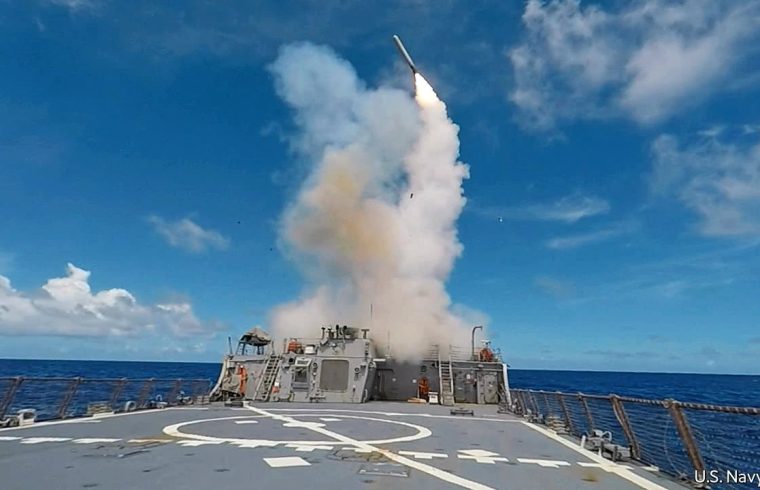
ON APRIL 7th a salvo of missiles fired by American warships in the Mediterranean scored direct hits on several Syrian aircraft shelters from hundreds of miles away, demonstrating once more the effectiveness of precision, or “smartâ€, weapons. At $ 1.3m apiece such missiles are usually reserved for important targets like parked aircraft. They are too pricey to be expended on lightly armed insurgents. (As George Bush junior once memorably put it, he was not prepared to “fire a $ 2m missile at a $ 10 empty tent and hit a camel in the buttâ€.)
Frank Fresconi, who works at the Army Research Laboratory’s Aeromechanics and Flight Control Group, in Maryland, hopes to change that. He is working on something called the Collaborative Cooperative Engagement (CCOE) programme, which hopes to provide the advantages of smart weapons at a fraction of the cost. A new generation of cut-price precision munitions could change the way America’s army wages war, for despite being the world’s most technologically advanced and generously funded force, it still employs a great deal of cheap, dumb, unguided weapons.
The idea is to link an individual smart munition with a flock of dumber, cheaper companions. The smart round uses its sophisticated sensors to find targets, and passes data to its less able comrades. The smart weapon handles all of the tricky navigation and target identification; its companions just have to work out where they are in relation to their master, and then go where they are told. Data are passed between them in brief radio chirps.
Dr Fresconi is not making a specific missile. Rather, he and his team are developing the electronic building blocks needed to assemble a wide range of different weapons. The results might be fired from a mortar, from a cannon, from a rocket launcher mounted on a lorry, or from the sort of weapon an individual solider might carry. In each case, a shell or rocket would release a swarm of submunitions. Under the guidance of the master weapon, these might disperse to attack individual enemy foxholes, or work together to hit a single target like a tank or a bunker simultaneously.
Precision guidance brings advantages besides a higher hit rate. There is less risk of accidentally killing innocent bystanders. No ammunition is wasted blowing up things that are not the target. By eliminating waste, Dr Fresconi reckons that a smart artillery round might get away with using a warhead one tenth the size of an unguided one for the same destructive effect.
The biggest challenge is navigation. Many existing smart weapons use GPS, which relies on signals from satellites that may be jammed by a sophisticated opponent. Others use laser guidance, which demands a soldier be close enough to the target that he can highlight it with a laser designator. The new architecture will avoid both those drawbacks by using optical techniques: guiding itself by spotting landmarks, and recognising targets visually. Dr Fresconi says the inspiration for the optical sensors came from the commercial world, where facial-recognition systems are used by everyone from Facebook to shops, policemen and airports.
The trick is to pack the necessary hardware into a few cubic centimetres, and to deal with the high speeds at which shells and missiles travel. Rather than having several seconds to scan their targets at leisure, as airport systems do, missiles will need to scan, recognise and act in milliseconds. And once the targets have been found, the weapons will need to be able to turn sharply at high speed. To do that, the team is fitting them with fins that deploy after launch, and pondering using sideways-facing rockets to give them even more agility.
All this wizardry must work not only when a munition has been “soft launchedâ€â€”dropped from a helicopter or a drone, in other words—but also when it has been fired out of a cannon or launched by a rocket. That will subject the electronics to extremely high g-forces, as they are accelerated to several times the speed of sound in milliseconds, or spun at thousands of revolutions per second when fired from rifled artillery barrels.
In recent tests a flock of multiple projectiles successfully navigated together. However, full realisation of the technology will take at least a decade to mature. The plan is to start big and scale down. CCOE will roll out gradually, says Dr Fresconi, with successive generations getting smarter and fitting into ever-smaller weapons.
As those weapons reach the battlefield, they will enable the use of new tactics. The manoeuvring munitions can carry out what the Army calls counter-defilade fire—hitting a sniper hiding behind a wall, for example, or troops concealed in trenches. Dr Fresconi also talks about “hyper precision†and being able to home in on a target’s weakest spot, or striking simultaneously at a precise point for maximum effect. And the munitions will afford a new capability for engaging dispersed targets. These might be enemy foot soldiers scattered over a wide area—or, in future, a swarm of hostile incoming drones. One missile full of Collaborative Cooperative munitions might hit the lot.
Finally, the new development could signal the end of indiscriminate artillery fire. By replacing dumb shells with smart ones, a barrage landing on a town would be more likely to hit only military targets, while—so the researchers hope—leaving civilians unharmed.







